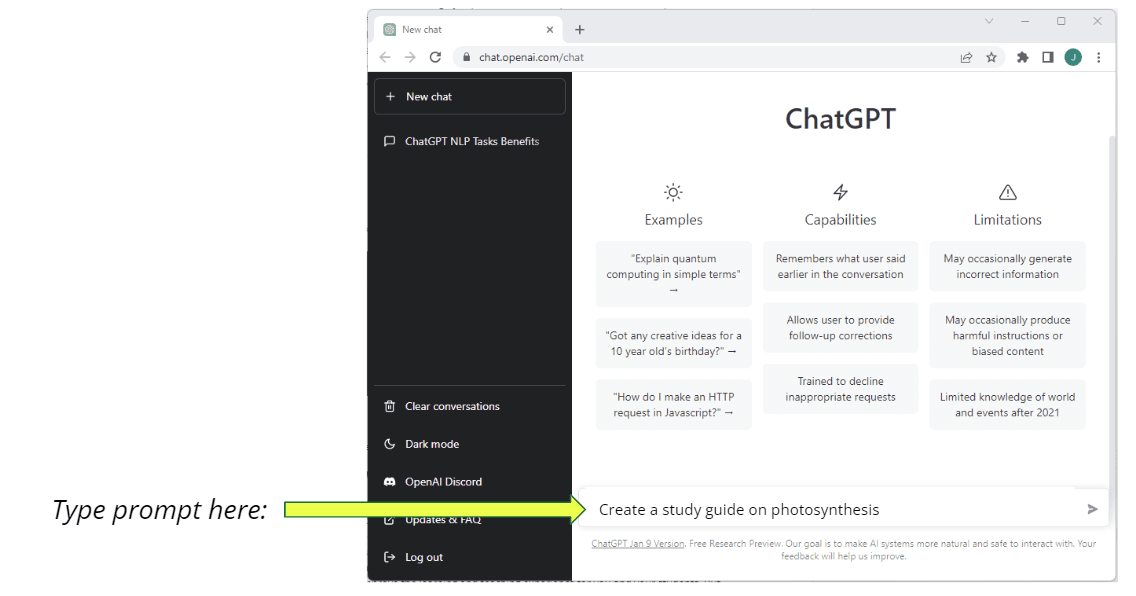How A.I. Tools like ChatGPT Work
What are A.I. tools like ChatGPT?
A.I. tools (like ChatGPT) are highly capable chatbots that produce a textual response to a wide range of worded prompts.
Unlike chatbots from the past, their responses are not pre-programmed. Rather, they use supervised machine learning techniques to predict the most logical sequence of textual output based on prior conversations and information available on the free internet (i.e. it is continuously learning).
See full resource: ChatGPT: Everything you need to know about OpenAI’s GPT-3 tool
What can they do?
Both the abilities and limitations of A.I. chatbots may be leveraged to improve the learning and teaching experience for you and your students. However, as new A.I. tools are released, and existing tools improve, we must recognize that these capabilities are not static.
What ChatGPT can do… TODAY:
- Produce good summaries of knowledge and procedures
- Produce texts that compare view or express judgment
- Restrict the production of dark, harmful, or biased content.
What ChatGPT cannot do… YET:
- Produce video, sound, or images
- Cite sources accurately
- Create rigorous, analytical text
- Extend or challenge what is currently known
How do they work?
ChatGPT relies on the use of prompts to generate a product or response.
A.I. Prompts
The key to using ChatGPT effectively is to be specific about the:
- topic
- desired output
- format of output
The more details and examples you add to the prompt, the better the output will be.

View example prompt with output
ChatGPT’s Approach to Answering Questions
Think of A.I. tools (like ChatGPT) as a very good detective. It doesn’t know for sure what the facts of an answer should be, but it tries, with impressive accuracy, to predict a logical sequence of human language text that would most appropriately answer the question.
Other Available A.I. Tools
Importantly, ChatGPT-3 is not the only A.I. tool available to you and your students. For instance, Google Bard, You.com, Microsoft Bing, and Perplexity A.I. are just a few of the A.I. tools that are either currently released, or in the process of becoming accessible to students. Furthermore, these tools are constantly learning and being updated to perform more complex tasks.
As such, the examples presented in these pages provide general guidance for the use of A.I. tools in education with the caveat that the visual representations of their output will likely change as the A.I. tools become more intelligent. With that being said, the opportunities and general principles for dealing with the reality of A.I. tools in education should continue to hold.
Links to A.I. Tools:
- ChatGPT: Optimizing Language Models for Dialogue
- Perplexity AI
- BLOOM: BigScience 176B Model
- You.com by Google
- Microsoft Bing
- Alpha: OPT-175B
- DeepMind
Additional Resources
- AI Guidance | Poorvu Center for Teaching and Learning
- Chat GPT Alternatives – essays, coding, search and chat – PC Guide
- How ChatGPT actually works
- How ChatGPT Works: The Model Behind The Bot | by Molly Ruby | Jan, 2023 | Towards Data Science
- Why the ChatGPT AI Chatbot Is Blowing Everybody’s Mind – CNET
- How Does ChatGPT Work? How Can ChatGPT Answer Questions?
- ChatGPT: Optimizing Language Models for Dialogue
- Generative AI Glossary (AIPRM) | Recommended by the Fullers Library STEM Club for Girls | London, UK